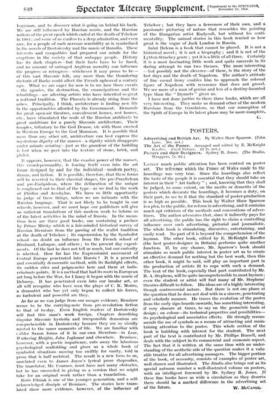POSTERS.
LATELY much public attention has been centred on poster art. The reference -which the Prince of Wales made to the hoardings was very true. Since the hoardings also reflect
the taste of the people it is essential that they should take an interest in their " Art Gallery " ; and, knowing that they shall be judged, to some extent, on the merits or demerits of the posters which decorate the hoardings, it becomes a duty, on their part, to see to it that the standard of poster-production is as high as possible. This book by Walter Shaw Sparrow is a plea, to the public, for reform in advertising, and it contains much apt criticism of the methods and conventions of adver- tisers. The author advocates that, since it indirectly pays for
all advertising, the public has the right to claim a controlling influence over such advertising, pictorial and journalistic. The whole book is stimulating, discursive, entertaining, and easily read. No part of it is beyond the comprehension of the layman. The other book, edited by E. McKnight Kauffer (the best poster-designer in Britain) performs quite another function. If, by any chance, Mr. Sparrow's book should stimulate so much public interest in poster art as to create an effective demand for nothing but the best work, then this other book, it might be said, will play an important part in the production of artists fit to cope "with such a demand. The text of the book, especially that part contributed by Mr. R. A. Stephens, will be quite incomprehensible to most laymen I even the student or artist will find many of Mr. Stephens' -theories difficult to follow. His ideas are of a highly interesting though controversial nature. But there is not one phase of the question that he does not deal with in a sincere, penetrating and scholarly manner. He traces the evolution of the poster from the early sign=boards onwards, has something interesting, if very obscure at times, to say on the geometric basis of design ; on colour—its technical properties and possibilities—
its psychological and associative effects. He strongly recom- mends the use of symbols as a means of attracting and main- taining attention to the poster. This whole section of the book is bubbling with interest for the student. The next part of the text is contributed by Mr. Phillips Russell, and deals with the subject in its commercial and economic aspect. The fact that it is written at the same time with an under- standing of the aesthetic side of the question makes it a valu- able treatise for all advertising managers. The bigger portion of the book, of necessity, consists of examples of poster art,
well chosen and illustrated. The Studio also brings out as its special autumn number a well-illustrated volume on posters, with an intelligent foreword by Mr. Sydney R. Jones. If these fine books have as wide a circulation as they deser4 there should be a marked difference in the advertising art


























































 Previous page
Previous page